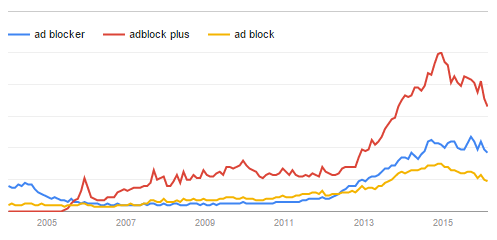Ad blocking and the Publisher Model

by AgencyUK’s Digital Media Manager, Ian Young
Online ad blocking is a hot topic right now. According to PageFair, the number of UK users of ad blocking tools reached 12 million last year. The graph below shows the increasing trend in the number of consumer searches on Google for ad blocking terms. It’s an issue which isn’t going away any time soon.
In recent months the subject has been highlighted further with big players in the online space voicing their opinions. As mentioned previously, EE is looking at ways to give its customers tools to block certain mobile ad formats, whilst wired.com is going to ask for a $1 weekly subscription for users to view an ad free version of its site. This has implications not just for advertisers, who might begin to question the ability of online advertising to reach their target audience, but also importantly for publishers as well.
The majority of online publishers work on an ad funded model, with revenue from advertising used to bankroll their editorial content. The implications of ad blocking on revenue and therefore sustainability are clear. One thing that isn’t clear is how to approach the issue and different publishers have different opinions.
A number of options are open to publishers:
- Paywall – Move to a subscription based model with no, or little advertising
- Content blocking – Block certain content to visitors using ad blocking software
- Circumvention – Use countermeasure software to deliver ads even if a user has an ad blocker installed
However, these options come with their own set of problems. Not all publishers can get away with a paywall model and may find that the loss in advertising revenue far outweighs the income from those prepared to pay for the content. Content blocking and the use of countermeasure software are both very confrontational models. They are in effect trying force the user into something they don’t want to do, something which could have dire consequences for the publisher’s brand and traffic levels.
What none of these options do is address the real issue. The question that publishers should be asking is why has there been such an increase in the use of ad blockers? It’s an easy question to answer really. People are getting hacked off with their online experience being made worse by advertising which is intrusive, not relevant, slow to load or even just not interesting.
Ultimately many publishers have been guilty of a lack of thought about user experience and have focused on maximising ad revenue. The industry has also been slow to develop standardised criteria for the number and delivery of ad formats to ensure faster load speeds and avoid intrusive elements such as video autoplay, default sound on and scroll over expandable formats. If publishers want to stem the tide of ad blocking technology and protect their revenue and their brand, then it will take a concerted and unified effort to ensure that the balance between content and advertising finds a point that users are prepared to accept.



